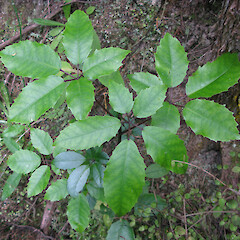Pseudopanax arboreus
Common name
fivefinger, five finger, whauwhaupaku
Synonyms
Panax arboreus Murray, Panax arboreus Murray var. arboreus, Neopanax arboreus (Murray) Philipson var. arboreus, Pseudopanax arboreus (Murray) Philipson
Family
Araliaceae
Flora category
Vascular – Native
Endemic taxon
Yes
Endemic genus
Yes
Endemic family
No
Structural class
Trees & Shrubs - Dicotyledons
NVS code
The National Vegetation Survey (NVS) Databank is a physical archive and electronic databank containing records of over 94,000 vegetation survey plots - including data from over 19,000 permanent plots. NVS maintains a standard set of species code abbreviations that correspond to standard scientific plant names from the Ngä Tipu o Aotearoa - New Zealand Plants database.
PSEARB
Chromosome number
2n = 48
Current conservation status
The conservation status of all known New Zealand vascular plant taxa at the rank of species and below were reassessed in 2017 using the New Zealand Threat Classification System (NZTCS) – more information about this can be found on the NZTCS website. This report includes a statistical summary and brief notes on changes since 2012 and replaces all previous NZTCS lists for vascular plants.
Please note, threat classifications are often suggested by authors when publications fall between NZTCS assessment periods – an interim threat classification status has not been assessed by the NZTCS panel.
- Conservation status of New Zealand indigenous vascular plants, 2017 . 2018. Peter J. de Lange, Jeremy R. Rolfe, John W. Barkla, Shannel P. Courtney, Paul D. Champion, Leon R. Perrie, Sarah M. Beadel, Kerry A. Ford, Ilse Breitwieser, Ines Schönberger, Rowan Hindmarsh-Walls, Peter B. Heenan and Kate Ladley. Department of Conservation. Source: NZTCS and licensed by DOC for reuse under the Creative Commons Attribution 4.0 International licence.
2017 | Not Threatened
Previous conservation statuses
2012 | Not Threatened
2009 | Not Threatened
2004 | Not Threatened
Brief description
Small bushy tree with glossy green fleshy toothed leaves arranged in fans of 5 (occ. up to 7) leaflets. Fruit purple, in obvious clusters
Distribution
Endemic. Widespread (though rare in Central Otago). North and South Islands
Habitat
Coastal to montane (10-750 m a.s.l.). Moist broadleaf forest. Frequently epiphytic. A frequent component of secondary forest. Streamsides and forest margins.
Wetland plant indicator status rating
Information derived from the revised national wetland plant list prepared to assist councils in delineating and monitoring wetlands (Clarkson et al., 2021 Manaaki Whenua – Landcare Research Contract Report LC3975 for Hawke’s Bay Regional Council). The national plant list categorises plants by the extent to which they are found in wetlands and not ‘drylands’. The indicator status ratings are OBL (obligate wetland), FACW (facultative wetland), FAC (facultative), FACU (facultative upland), and UPL (obligate upland). If you have suggestions for the Wetland Indicator Status Rating, please contact: [Enable JavaScript to view protected content]
UPL: Obligate Upland
Rarely is a hydrophyte, almost always in uplands (non-wetlands).
Detailed description
Us. Dioecious. Small multi-branched tree to 8 m tall, branches and branchlets brittle. Leaves alternate, leaflets 5-7 (us. 5), palmate. Petioles c. 15-20 cm long, sheathing branchlet at base. Petiolules c. 3-5 cm long, pale green. Leaflets obovate-oblong to oblong-cuneate, thinly coriaceous, coarsely serrate-dentate, acute or acuminate to obtuse; midveins and main lateral veins obvious above and below; teminal lamina 10-20 x 4-7 cm. Inflorescence and panicle, terminal, compound; flowers usually unisexual; 8-20 primary rays (branchlets), up to 10 cm long; 15-20 secondary rays; umbellules with 10-15 flowers in each. Calyx truncate or obscurely 5-toothed; flowers c. 5 mm diam., sweet-scented; petals 5, white to pink flushed, ovate to triangular, acute; stamens 5, obvious, filaments c. = petals; ovary 2-loculed, each containing 1(-2) ovules; style branches 2, spreading. Fruit fleshy, 5-8 mm diam., style branches retained on an apical disc, very dark purple, laterally compressed. Seeds 2(-3) per fruit, wrinkled, 3-6 mm long.
Similar taxa
Similar to other Pseudopanax species, but has a greater number of leaflets borne on distinct petiolules. Vegetatively similar to Schefflera digitata (pate) which has thinner, finely serrate and larger leaflets with usually 7 leaflets per leaf.
Flowering
June to August
Flower colours
Red/Pink, White
Fruiting
August to February
Propagation technique
Easy from fresh, cleaned, seed
Threats
Not Threatened. In places the petiolules of Pseudopanax arboreus (and other fleshy-leaved Pseudopanax species) are a conspicuous element of possum (Trichosurus vulpecula) diet and the forest floor can become littered with discarded leaflets.
Etymology
pseudopanax: False cure
arboreus: From the Latin arbor ‘tree’, meaning tree-like
Taxonomic notes
This species was transferred back to Neopanax Allan by: Frodin, D.G.; Govaerts, R. 2003: World Checklist and Bibliography of Araliaceae, The Cromwell Press, European Union.
Attribution
Description adapted from Allan (1961) and Webb and Simpson (2001).
References and further reading
Allan, H.H. 1961. Flora of NZ, Vol. I. Government Printer, Wellington
Webb, C.J. & Simpson, M.J.A. 2001. Seeds of NZ gymnosperms and dicotyledons. Manuka Press, Christchurch.
NZPCN Fact Sheet citation
Please cite as: de Lange, P.J. (Year at time of access): Pseudopanax arboreus Fact Sheet (content continuously updated). New Zealand Plant Conservation Network. https://www.nzpcn.org.nz/flora/species/pseudopanax-arboreus/ (Date website was queried)















